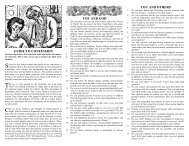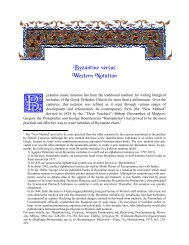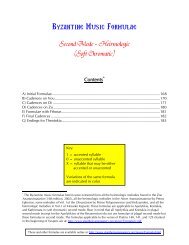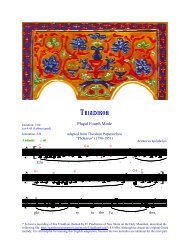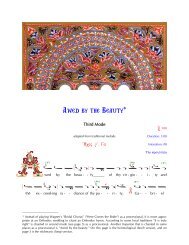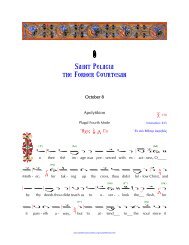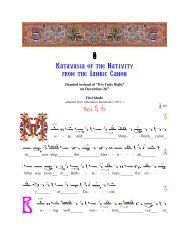14. THEORY and PRACTICE.One of the less acceptable aspects of many conventional manuals of Psaltic theory, is theeasy and oft repeated assertion that there is a difference between theory and practice.This view has at least an ancient pedigree: the theoretical manuals produced in thePalaiologan period accepted the same view. Already in the Mediaeval manuals the gapbetween theory and practice emerges since the theorists were determined to deal withinteresting mathematical aspects of musical theory that might find little image inpractice, and equally since the authors based their theorizing on older texts which bothattempted to link Byzantine music with what they knew of ancient Greek music, andtended to discuss the chant as it may have existed at an earlier period rather thananalyse contemporary practice.Byzantine chant is part of a living, developing musical and liturgical culture. Externalinfluences played a significant role in the chant's development. During the period ofOttoman rule, the great Psaltai of Constantinople found themselves in demand as courtsingers. Many Psaltai studied and performed Ottoman Perso-Arabic classical music aswell as Byzantine <strong>Psalmodia</strong>. Indeed, Peter Lampadarios, Konstantinos Protopsaltes,Zacharias Hanade and Theodoros Phokaeos were all great experts on Ottoman music aswell as significant figures in the history of modern <strong>Psalmodia</strong>.Eighteenth century theorists of <strong>Psalmodia</strong> freely accepted the identity of the Tones ofPsaltic chant and certain of the Maqams (modes) of Ottoman music. KonstantinosProtopsaltes explains the relation between Tones and Maqams with quite extraordinaryclarity and conciseness in what was published later as the Ermeneia Tis ExoterikesMousikes. His exposition makes it evident that a family of maqams corresponds to eachTone, each maqam differentiated from the other by a subtle difference in the tuning ofspecific notes, or by a different pattern of melodic progress in ascent or descent or both,and a difference in range. The <strong>Psalmodia</strong> of the Ottoman period was composed bymusicians who were frequently steeped in Ottoman court music as much as inByzantine chant, were familiar with Muslim religious music, and often acquainted withboth the notation and the practice of Western European music. It should not, then, be asurprise that the Psaltic compositions we have inherited bear the marks of both Ottomanand Western influences: the great Psaltai who composed or arranged the chant wereworking within a living and confident tradition that was open to adaptation, and theywere ready to take into Psaltic practice elements that enhanced and beautified it, ratherthan attempting to maintain absolute purity of tradition.For theorists, the flexibility and adaptability of the Psaltic tradition poses a problem. Thebooks produced by their predecessors describe an earlier state of <strong>Psalmodia</strong> that can besignificantly different from contemporary practice. There is, moreover, a considerableproblem for theorists in finding the right balance between prescriptive and descriptiveapproaches. It is, for example, quite clear that modern Psaltai generally use a scale forpieces in Tone IV on Vu which uses different notes from the scale they use to sing piecesin Tone VIII. Now, how is the theorist to cope with this? Is the practise of singing ToneIV on Vu in a distinctly non-diatonic mode simply a corruption of the diatonic system tobe ignored by the theorist, or is the theorist to measure the intervals actually used whenTone IV is sung in this non-diatonic mode, and to present these as the tuning of Tone IV
on Vu? The same question arises with regard to the modern custom of flattening Vu indescent in Tone I: is this a corruption or simply a new development?Certainly, Petros Lampadarios might have been surprised to hear a modern version ofthe Kanon in IV or the introduction of a flattened Vu into his compositions in Tone I. Onthe other hand, he would have noticed that the Anastasimatarion usually publishedunder his name does not actually contain his music as he wrote and sang it, but anineteenth century version of it edited by John the Protopsalt. Indeed, much of theclassic repertoire of chant does not consist of classic pieces in their original form, but inan edited and reworked form better adapted to the taste of a later period, frequently bymelodic elaboration and enhanced chromaticism.At the end of the day, it is neither possible nor desirable to freeze <strong>Psalmodia</strong> in the formcurrent at some particular period of history. Procrustes must not become the patronsaint of Psaltic practice. On the other hand, a merely descriptive approach to Psaltictheory poses two virtually insoluble problems, collection and selection - how to collectthe enormous mass of evidence that would be required in order to describe the fullrange of Psaltic practice, and how to select precisely which version of the practice is tobe taught.In this manual, I advise singers not to take up the habit of flattening Vu in Tone I and toconsider using a true diatonic tuning of Tone IV. The reason for these choices is partly amatter of musical taste, partly a desire to defend a conservative version of Psalticpractice, partly a wish to have the classic repertoire sung in a tuning its composerswould recognize, and partly a feeling that the modern taste for florid psaltic musicornamented with complex chromatic flourishes is inappropriate to a liturgical art, putsan unnecessary price on virtuosity and emotionalism, and, given where this book iswritten, is singularly ill-suited to the development of <strong>Psalmodia</strong> in Great Britain.C] DIATONIC and ENHARMONIC.There is a close relation between the diatonic modes and the so-called enharmonicmodes. In order to sing the scale of Tone III, for example, all that is required is that thenotes Vu and Ke are sung slightly sharper than in the corresponding diatonic scale.ConsiderDiagram G:DIATONIC SCALE ON GA|------------|----------|--------|------------|------------|----------|--------|GA DI KE ZO NI PA VUENHARMONIC SCALE ON GA|------------|------------|------|------------|------------|------------|------|GA DI KE ZO NI PA VUAs the diagram makes clear, the notes Ga, Di , Zo, Ni, and Pa of the diatonic scale on Gaare sung at exactly the same pitch as the corresponding notes in the enharmonic scale onGa.





